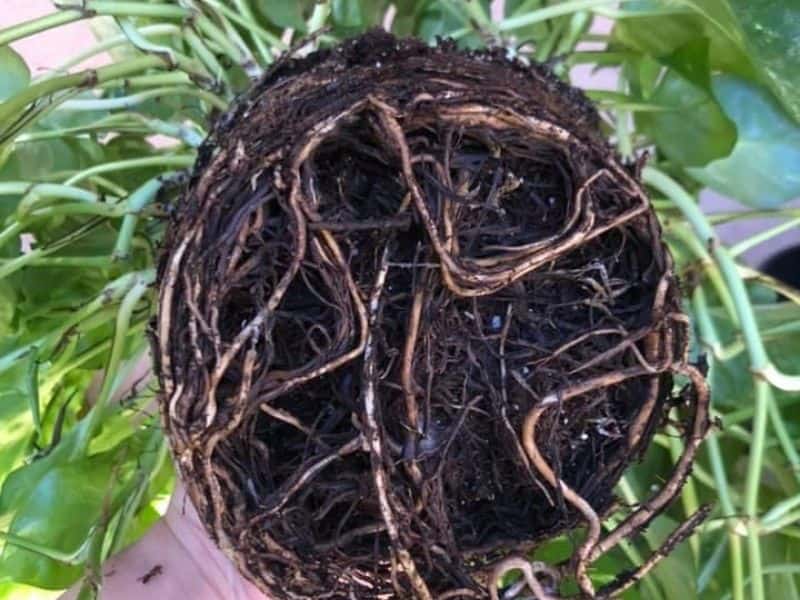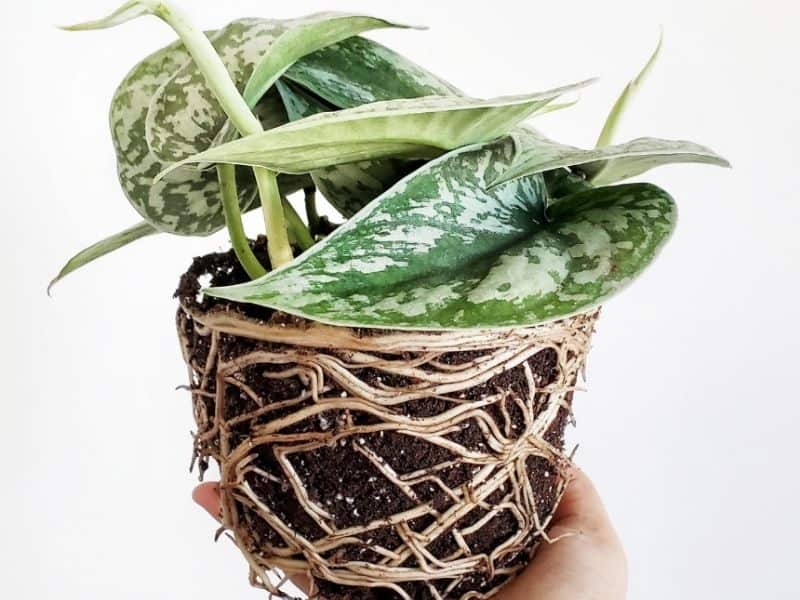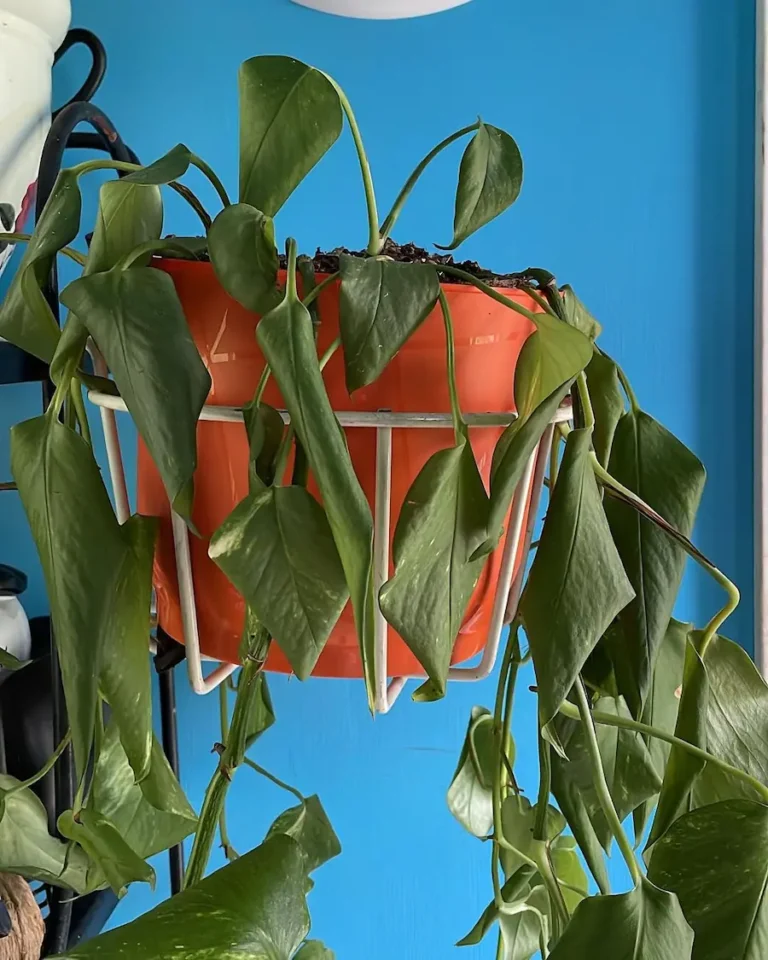Root Bound Pothos – Signs + How to Repot the Plant
A pot-bound pothos does not have enough soil to hold nutrients and water for all those roots because the pot is filled with roots. Being root-bound is not good for the health and growth of these houseplants. What are the signs of rootbound pothos and how do you fix the problem?
Remove the root-bound pothos from its pot and then prune and detangle the bunched-up roots. Fill a larger container with a new, freshly-prepared potting mix and replant your pothos in it. Water lightly to help the plant recover from repotting stress.
Pothos grow fairly fast and can soon become too large for the pots in which you originally planted them.
Do pothos like to be pot bound?

Pothos don’t like to be root-bound. They prefer pots with enough room for the root ball to grow freely. Pot-bound roots will lead to stunted growth, drooping leaves, yellowing, legginess, and general ill-health due to reduced ability to absorb oxygen, water, and nutrients from the soil.
Pothos roots have enough soil space in their natural habitat that allows for root expansion and optimal intake of moisture and nutrients. That’s why pothos can grow full and bushy easily. However, when grown in a small pot, the plant’s roots have to make use of the limited soil space and resources.
Roots begin to grow in a spiral pattern at the bottom of the pot when they run out of space. There can only be so much oxygen, moisture, and nutrients in the space within which the spiraling roots are pot-bound. The reduced ability to feed due to the bunched-up roots leads to signs of stress.
Signs of a root-bound pothos
Symptoms of pot-bound pothos are quite difficult to identify above the soil because they are a lot similar to signs of overwatering and underwatering. For example, the leaves of your pothos will curl and wilt easily with the plant suffering from stunted growth. The best way to diagnose the plant is to remove it from the pot and have a look at the roots.
Here are the signs of root-bound pothos:
Stunted growth
The first sign you might notice when the plant outgrows its pot is stunted growth. A smaller pot prevents pothos from growing big. If the container is less than 10 inches deep, it is likely that the plant’s roots are bunched up.
Pro tip: It is not a good idea to prune pothos roots and foliage too often to force it to fit in a small container. Simply repot the plant every two years into a container that’s about 2 inches larger than the older pot to keep up with root growth.
Spiraling roots

If you uproot your pothos and notice that its roots are forming a spiral pattern at the bottom, you’re growing the plant in a pot that’s too small for it. The root system forms a dense ball of roots as soil space becomes limited. You may also notice some of the roots creeping through the pot’s drainage holes.
Cracks in the pot
Crack lines in the pothos container are a sign that the plant’s roots are pot-bound. Your pothos can become root-bound either because you grew it in a pot that’s too small, or the plant’s roots have outgrown the space available inside the pot. As the roots grow further, they put pressure on the inside walls of the pot, causing it to expand. In extreme scenarios, the pot may crack or break.
Roots growing upwards through the topsoil
Although pothos have aerial roots just like philodendrons, a new growth of roots creeping through your topsoil could be a sign that the available soil inside the pot is already too packed with roots that it cannot accommodate any more.
You’ll begin to see signs of cracking and flakiness on the soil surface as the roots grow through the top layer of soil. What’s more, if you irrigate and the topsoil dries up too fast, it’s time to uproot the pothos and save it from being root-bound.
Leaf discoloration and wilting
Another signs of root bound houseplants is leaves turning yellow or brown. Yellow pothos leaves is one sign of moisture problems – either underwatering or overwatering. However, pothos becoming root-bound can also cause this kind of foliage discoloration especially on the leaves that occur close to the base of the plant. Leaves of root bound pothos may also appear limp and start wilting.
How to repot a root bound pothos
The basic care requires that you repot your pothos houseplants every 2-3 years to prevent them from becoming root-bound. Observe the length of the trails to determine whether your pothos is ready for repotting. This is because the taller the trails grow, the more extensive the root system grows as well.
However, if you look through the pot’s drainage holes and can already see parts of the root system, the plant is already root-bound and that’s your cue to repot it.
Here’s a detailed procedure on how to properly repot a root-bound pothos plant:
1. Uproot the plant
First, uproot the pothos to examine whether there’s root-ball spiraling, which is a clear indicator that a plant is root-bound. Remember, forcefully pulling the pothos off the pot may cause damage to the plat.
To properly remove the plant from the pot, tilt the pot over and gently tap at the bottom. If it’s a flexible plastic container, you can press it from the sides until it slide out the pothos.
2. Prune and loosen the roots
Next, cut back some of the roots using a pair of shears, following in the shape of the root-ball. Pruning the roots allows them to regrow with more vigor once repotted. Free up the roots that are bundled in a tight spiral inside the root-ball due to the limited space inside the old pot.
To free up the bound roots, use a fork or any other similar pronged tool that can easily loosen the soil in the root-ball.
As you loosen and disentangle the root-ball, spread the freed-up roots outwards to discourage any future spiral growth patterns that can choke out the pothos once the plant is repotted. Also, check for any signs of root rot to avoid repotting a rootbound pothos with a fungal infection spreading in the soil.
3. Prepare a fresh soil mix
Get a new pot that’s at least 2 inches deeper and wider than the previous one to accommodate the pothos plant’s moderate-fast growth over the next three years.
Prepare a new potting mix that’s rich in organic ingredients, making sure it’s substantial to accommodate extensive pothos root growth. I recommend filling up at least half of the container with the fresh soil mix.
4. Repot the pothos
Replant the pothos back into the new, more spacious pot, making sure that the freshly-pruned root-ball is completely covered with soil. Meanwhile, use a stick to fill up spaces along the sides of the container with more soil.
5. Water the pothos
After repotting the root bound pothos, water it lightly and keep the soil moist all the time to allow the plant to recover from potting stress quickly.
It is normal to see signs of stress including drooping and wilting because the plant has been disturbed during the process of fixing its bound roots. Give it a little more time to recover and grow healthy and happy.
How to Prevent Pothos from Being Pot Bound
The best way to prevent roots from being pot bound is to ensure the container’s size is big enough to allow the roots of Epipremnum aureum (pothos) plants to grow freely. But, that’s not the only practice that will keep the plant growing healthy.
Here are tips to prevent pot-binding your pothos:
- Repot every 2-3 years: Repotting is a great way of keeping up with the growth of pothos. If your plant is growing in a relatively small pot, consider repotting it once every 2-3 years. Replant in a pot that’s at least 2-inches wider and deeper than the old pot to provide more room for the roots to grow.
- Prune the plant periodically: Instead of leaving your houseplant to be pot bound, remove it from the pot and prune the roots at once a year. Prune carefully not to stress the plant too much. Instead, you want to control how big the root ball grows to stop it from overgrowing the planter.
- Divide the plant: Pothos can be easily divided to fix the problem of being pot bound. Dividing will produce new plants, which is better than letting them suffer stunted growth and other signs of ill health.
While most plants can survive even when pot-bound, no plant wants to grow in these conditions. To keep your pothos happy and healthy, try to mimic its natural habitat.
Resources
- KATHY KELLEY, PH.D., Pennstate Extension: Repotting Houseplants
- David Hillock, Oklahoma State University Extension – Houseplant Care



![Pothos Leaves Curling [Causes + Easy Ways to Fix Leaf Curl]](https://gardenine.com/wp-content/uploads/2020/11/Pothos-leaves-curling.jpg)
![Pothos vs. Philodendron: Differences [Pictures + Identification]](https://gardenine.com/wp-content/uploads/2020/12/Pothos-vs-Philodendron-leaf-shape-and-texture-768x576.jpg)


